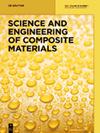A numerical study on the spatial orientation of aligning fibrous particles in composites considering the wall effect
IF 1.6
4区 材料科学
Q3 Materials Science
引用次数: 0
Abstract
Abstract The reinforced efficiency of steel fibers in composites is closely related to their spatial orientation, which can be generally driven by the external magnetic force and restricted by the wall effect of rigid boundaries of the container. To clarify the spatial orientation of steel fibers in composites considering the effect of rigid boundaries under the electromagnetic field, a series of two-phase models consisting of fibrous particles and homogeneous matrix are generated, in which the fibers are separately simplified as spherocylindrical, cylindrical, and linear particles. Based on these models of the semi-periodic boundaries, the effect of fiber characteristics (e.g., the fiber content V f, fiber aspect ratio ε, fiber length l sf, and fiber style) on both the spatial distribution and orientation degree of fibrous particles is studied before and after the fibers are aligned by the magnetic force. The results revealed that (1) both the effective number N A and orientation degree ξ of fibrous particles at a cross-section of the container can be greatly increased when the electromagnetic field is applied and (2) the wall effect of rigid boundaries shows an adverse impact on the amelioration of N A and ξ, and the range size of the affected region is essentially equal to the effective length of fibrous particles of different shapes (e.g., l sf + D sf) for spherocylindrical particles and l sf for cylindrical and linear particles).考虑壁效应的复合材料中排列纤维颗粒空间取向的数值研究
摘要钢纤维在复合材料中的增强效率与其空间取向密切相关,空间取向通常受外部磁力的驱动,并受容器刚性边界的壁效应的限制。为了阐明在电磁场作用下考虑刚性边界影响的复合材料中钢纤维的空间取向,建立了一系列由纤维颗粒和均匀基体组成的两相模型,其中纤维分别简化为球形、圆柱形和线性颗粒。基于这些半周期边界模型,研究了纤维在磁力排列前后纤维特性(如纤维含量Vf、纤维纵横比ε、纤维长度lsf和纤维类型)对纤维颗粒空间分布和取向度的影响。结果表明:(1)当施加电磁场时,容器横截面上纤维颗粒的有效数量NA和取向度ξ,并且受影响区域的范围大小基本上等于不同形状的纤维颗粒的有效长度(例如,lsf + Dsf),而lsf用于圆柱形和线性粒子)。
本文章由计算机程序翻译,如有差异,请以英文原文为准。
求助全文
约1分钟内获得全文
求助全文
来源期刊

Science and Engineering of Composite Materials
工程技术-材料科学:复合
CiteScore
3.10
自引率
5.30%
发文量
0
审稿时长
4 months
期刊介绍:
Science and Engineering of Composite Materials is a quarterly publication which provides a forum for discussion of all aspects related to the structure and performance under simulated and actual service conditions of composites. The publication covers a variety of subjects, such as macro and micro and nano structure of materials, their mechanics and nanomechanics, the interphase, physical and chemical aging, fatigue, environmental interactions, and process modeling. The interdisciplinary character of the subject as well as the possible development and use of composites for novel and specific applications receives special attention.
 求助内容:
求助内容: 应助结果提醒方式:
应助结果提醒方式:


